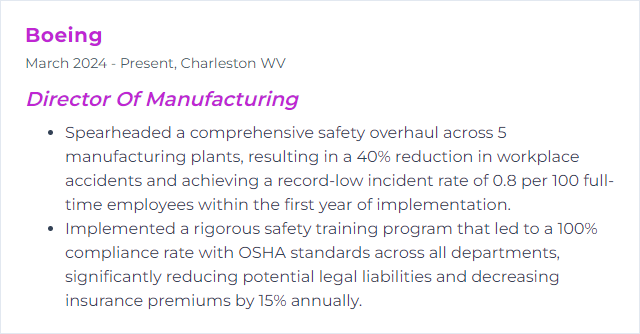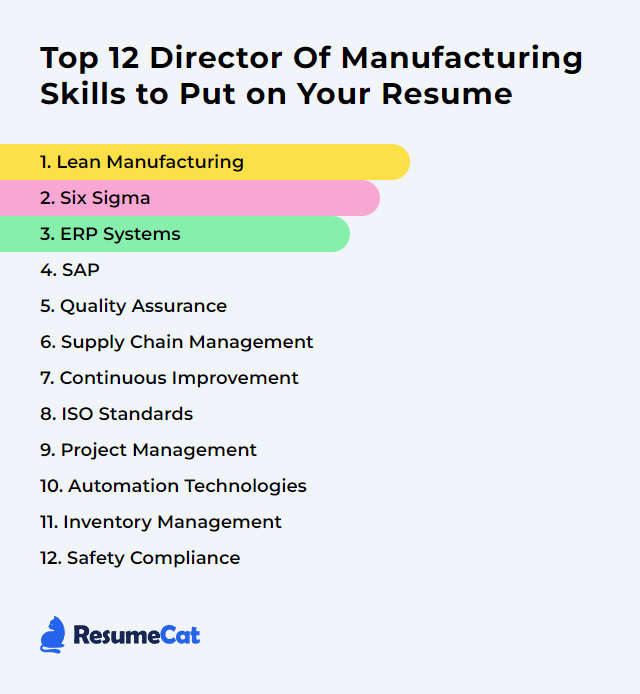Top 12 Director Of Manufacturing Skills to Put on Your Resume
In a crowded manufacturing landscape, a Director of Manufacturing rises by pairing hard-nosed technical know-how with clear-eyed leadership. Put the right skills up front and hiring managers see proof: you can steady the line, sharpen throughput, and guide teams through shifting demand without losing quality or cadence.
Director Of Manufacturing Skills
- Lean Manufacturing
- Six Sigma
- ERP Systems
- SAP
- Quality Assurance
- Supply Chain Management
- Continuous Improvement
- ISO Standards
- Project Management
- Automation Technologies
- Inventory Management
- Safety Compliance
1. Lean Manufacturing
Lean Manufacturing is a practical system for stripping away waste and smoothing flow so every minute, motion, and material adds customer value. Less clutter, more throughput, fewer surprises.
Why It's Important
Lean cuts delays and defects, shortens cycle time, and lowers cost without starving quality. That trifecta tightens competitiveness and frees cash to invest where it actually counts.
How to Improve Lean Manufacturing Skills
Move deliberately. Then move faster:
Value Stream Mapping: Map end-to-end flow to expose bottlenecks, rework loops, and idle time. Fix what the map reveals, not what you assume.
5S as bedrock: Sort, Set in order, Shine, Standardize, Sustain. A tidy, visual workplace makes waste visible and mistakes harder to hide.
Daily continuous improvement: Build quick kaizen cycles into the cadence. Small wins, stacked relentlessly, change the physics of the line.
Pull with Kanban: Produce to demand signals, not forecasts. Trim WIP, shrink lead times, calm the chaos.
Lean tools that bite: PDCA, root cause analysis, A3 thinking, SMED for changeovers. Use the right lever for the right constraint.
Digitally informed: IoT, MES, and real-time dashboards amplify Lean by tightening feedback loops and catching drift early.
Teach and empower: Train everyone, push decisions to the edge, recognize improvements fast. Ownership fuels sustainment.
Lean isn’t a project. It’s the operating system.
How to Display Lean Manufacturing Skills on Your Resume
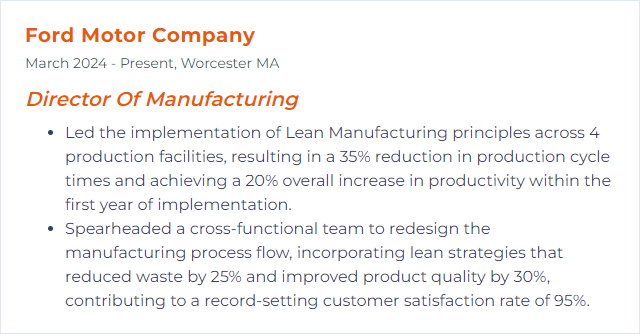
2. Six Sigma
Six Sigma is disciplined, data-first problem solving. Reduce variation, drive down defects, and lock in capability with DMAIC and statistical rigor.
Why It's Important
When processes behave, costs tumble and customers stop complaining. Yield rises, scrap falls, confidence grows. Precision pays.
How to Improve Six Sigma Skills
Lead with intent: Set expectations for data-driven decisions. Sponsor projects. Remove roadblocks.
Build belts: Train Yellow, Green, and Black Belts. Mix classroom with coached, real projects.
Pick the right battles: Prioritize projects tied to customer pain, margin lift, and flow. Say no to vanity metrics.
Tool up: Use SPC, DOE, and capable analytics software (e.g., Minitab) to cut through noise.
Make it cultural: Pair Six Sigma with Lean. Share wins. Standardize improvements so they stick.
Measure, then tighten: Track DPMO, Cpk/Ppk, cycle time, savings. Adjust course fast when the data twitches.
How to Display Six Sigma Skills on Your Resume
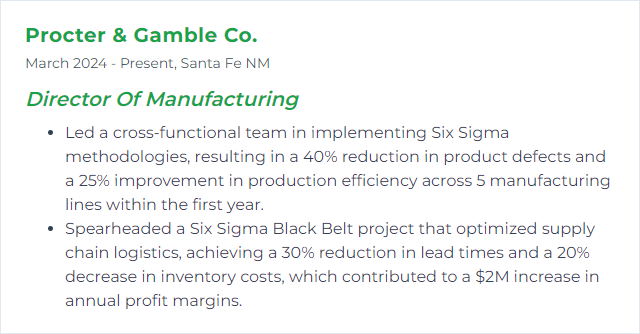
3. ERP Systems
ERP platforms connect the factory to finance, supply to sales. One source of truth for planning, scheduling, inventory, quality, and cost.
Why It's Important
With ERP humming, you get real-time visibility, cleaner handoffs, and better decisions. Less spreadsheet wrangling, more production that ships on time.
How to Improve ERP Systems Skills
Integrate and automate: Tie ERP to CRM, MES, WMS, and SCM. Remove manual re-entry. Let workflows do the grunt work.
Fit to the business: Configure for your shop’s realities and keep custom code sparing. Design for scale.
Train relentlessly: Role-based training, clear SOPs, and super-users on the floor. Adoption beats features.
Analytics that matter: Build KPI dashboards for MRP accuracy, OTIF, OEE, and margin. Act on alerts, not hunches.
Any device, anywhere: Mobile access for approvals, inventory checks, and maintenance calls in the moment.
Govern and secure: Master data discipline, clean change management, and strong cybersecurity. Review and refine quarterly.
How to Display ERP Systems Skills on Your Resume
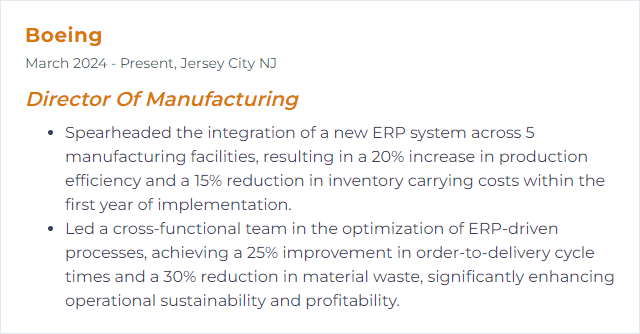
4. SAP
SAP is a comprehensive ERP suite used to run core operations—planning, production, quality, procurement, finance, and more—across a unified data model.
Why It's Important
SAP streamlines processes end to end, surfaces real-time insight, and stabilizes supply and production. That clarity turns firefighting into foresight.
How to Improve SAP Skills
Optimize core flows: Tune PP, MM, QM, and EWM settings so planning logic, shop-floor confirmations, and quality holds align with how you actually build.
Go modern: Move toward SAP S/4HANA where possible for speed and analytics. Use Fiori for intuitive, role-based screens.
Connect the line: Pair SAP with MES or SAP Digital Manufacturing and IoT signals for real-time equipment and WIP visibility.
Train and certify: Build an internal academy. Blend SAP Learning resources with mentor-led, scenario-based practice.
Redesign with insight: Use process-mining tools (e.g., SAP Signavio) to expose rework and detours, then simplify.
Stand up a Center of Excellence: Own governance, change control, and continuous improvement so enhancements don’t spiral into chaos.
How to Display SAP Skills on Your Resume
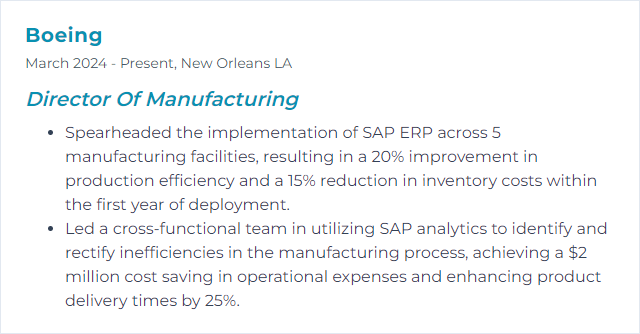
5. Quality Assurance
Quality Assurance ensures products meet requirements every time through planned, systematic activities—procedures, audits, testing, and feedback loops.
Why It's Important
Consistent quality protects brand trust, shields margins from scrap and returns, and keeps regulators content. Fewer surprises, fewer escalations.
How to Improve Quality Assurance Skills
Make quality the default: Leaders model it, metrics reinforce it, and every station knows the standard.
Lean + Six Sigma: Standardize work, stabilize processes, and attack root causes—not symptoms.
Develop the team: Ongoing training, relevant certifications, and hands-on coaching. Competence closes gaps.
Instrument the process: SPC on critical parameters, automated vision checks, and connected gauges for instant detection.
Strengthen supplier quality: Clear specs, APQP/PPAP where applicable, audits, and incoming inspection tuned by risk.
Close the loop: Use voice-of-customer and complaint data to prioritize fixes. CAPA that actually prevents recurrence.
How to Display Quality Assurance Skills on Your Resume
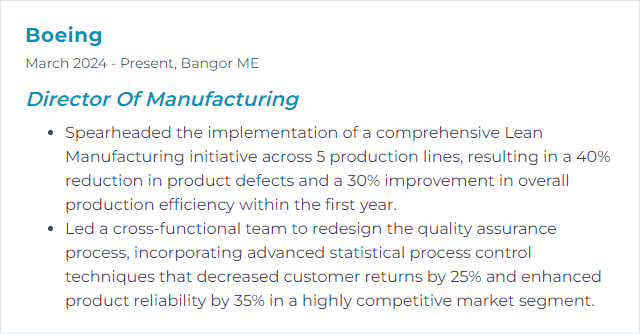
6. Supply Chain Management
Supply Chain Management orchestrates sourcing, planning, manufacturing, logistics, and service so materials show up, products flow, and customers get what they ordered—when they expect it.
Why It's Important
Strong SCM tames cost, protects delivery promises, and buffers volatility. It’s the backbone of reliable manufacturing.
How to Improve Supply Chain Management Skills
Modern planning: Use capable planning tools and accurate data for demand, supply, and production scheduling that don’t whiplash the floor.
End-to-end visibility: Build a control-tower view from supplier to customer. Exceptions surface early; expedites shrink.
Inventory discipline: JIT where it fits, safety stock where it doesn’t. Tune policies with ABC/XYZ analysis.
S&OP/IBP rhythm: Align sales, operations, and finance monthly. One plan, one set of numbers.
Partner hard: Share forecasts, scorecards, and improvement goals with suppliers and carriers. Collaboration beats confrontation.
Sustainable choices: Measure footprint, reduce waste, improve packaging, and design for circularity where feasible.
Risk readied: Diversify sources, qualify alternates, nearshore where it makes sense, and stress-test scenarios.
How to Display Supply Chain Management Skills on Your Resume

7. Continuous Improvement
Continuous Improvement is the never-done pursuit of better—incremental tweaks, occasional breakthroughs, and a drumbeat of learning that reshapes performance.
Why It's Important
Markets shift. Costs creep. CI keeps operations sharp, resilient, and faster than yesterday’s version of you.
How to Improve Continuous Improvement Skills
Lead visibly: Gemba walks, daily standups, and rapid feedback. Curiosity over blame.
Teach the toolkit: Lean, Six Sigma, problem-solving basics, and A3 storytelling. Make improvement accessible.
See the system: Map processes, quantify waste, and fix constraints—don’t just rearrange symptoms.
Engage everyone: Idea systems with quick evaluation and fast implementation paths. Celebrate wins loudly.
Try, learn, lock: Pilot changes, measure, standardize what works, and sunset what doesn’t.
Measure what matters: A tight set of KPIs tied to customer value, flow, cost, and safety.
Close the loop: Regular retrospectives to refine the approach and keep momentum.
How to Display Continuous Improvement Skills on Your Resume
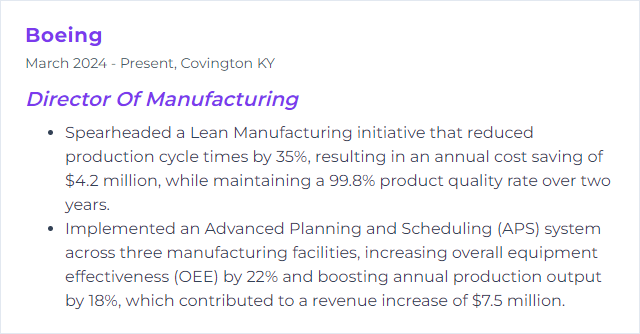
8. ISO Standards
ISO standards are agreed frameworks for quality, safety, environment, and more that make processes consistent and products dependable.
Why It's Important
Certification opens markets, hardens processes, and aligns teams. It’s structure with purpose, not paperwork for its own sake.
How to Improve ISO Standards Skills
Gap it: Compare current practice to the clause-by-clause requirements. Target nonconformities ruthlessly.
Train and involve: Everyone should know the why and the how. Ownership beats compliance theater.
Sharper processes: Streamline, standardize, and document the way work should flow. Make the right way the easy way.
Right-fit QMS: Build on ISO 9001 and add 13485, 14001, or 45001 where relevant. Keep it lean.
Audit with intent: Frequent internal audits and management reviews that drive action, not binders.
Digital control: Electronic document control, training records, and deviation/CAPA tracking for traceability.
PDCA always: Plan, Do, Check, Act until improvement becomes habit.
How to Display ISO Standards Skills on Your Resume
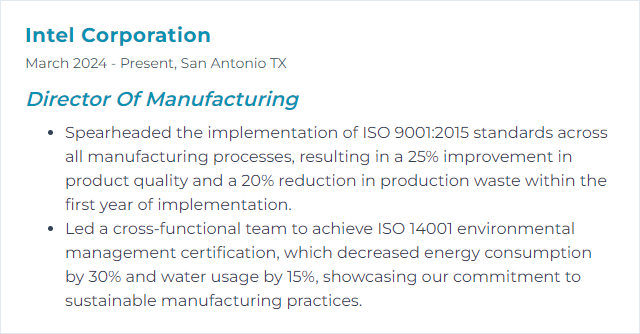
9. Project Management
Project management in manufacturing is the art of hitting scope, cost, and schedule while the shop stays productive and quality doesn’t blink.
Why It's Important
Good PM turns strategy into shippable reality. Resources align, risks shrink, and launches land smoothly.
How to Improve Project Management Skills
Hybrid methods: Blend stage-gate with Agile where it fits. Iterate on what’s uncertain; lock down what’s regulated.
Right tools: Use project and portfolio systems that tie tasks, budgets, and capacity to real-time status.
Clear communication: Cadenced updates, crisp RACI, single source of truth. Silence breeds surprises.
Continuous improvement: Retrospectives after each phase. Fold lessons learned into the next plan.
Build capability: Train PMs and technical leads; mentor on risk, cost control, and stakeholder management.
Risk first: Identify, quantify, and mitigate. Triggers, owners, and contingency baked in.
Measure outcomes: KPIs on schedule variance, cost performance, benefits realization, and adoption—not just activity.
How to Display Project Management Skills on Your Resume

10. Automation Technologies
Automation brings robots, cobots, sensors, and software together to handle repeatable work, boost precision, and keep lines running.
Why It's Important
It slashes variation, scales output, and frees people to solve tougher problems. And yes—24/7 throughput changes the math.
How to Improve Automation Technologies Skills
Keep learning: Track advances in robotics, vision, PLCs, and AI. Curiosity today prevents obsolescence tomorrow.
Pilot smart: Run small experiments, prove ROI, then scale. Kill what doesn’t earn its keep.
Upskill the team: Cross-train technicians on programming, troubleshooting, and safety. Depth and bench strength matter.
Flexible by design: Modular cells, quick-change tooling, and cobots for mixed-model agility.
Measure relentlessly: OEE, MTBF/MTTR, first-pass yield. Use analytics to spot drift and schedule predictive maintenance.
Vendor partnerships: Co-develop roadmaps, secure support SLAs, and learn from the broader automation community (e.g., A3).
Sustain and secure: Energy-efficient equipment, end-of-line waste reduction, and hardened OT cybersecurity.
How to Display Automation Technologies Skills on Your Resume
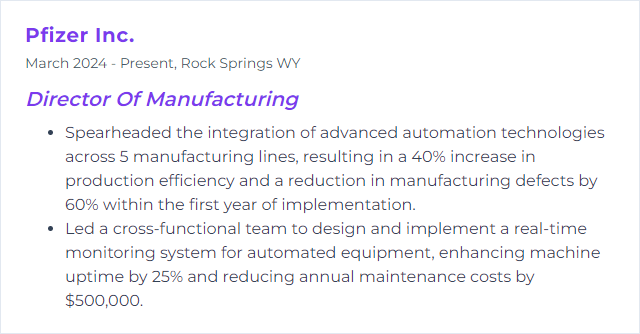
11. Inventory Management
Inventory Management controls what you buy, store, consume, and ship—ensuring materials are ready without burying cash on the shelf.
Why It's Important
Right-sized inventory speeds flow, cuts carrying cost, and prevents stockouts. Production stays fed; customers stay happy.
How to Improve Inventory Management Skills
Lean the stock: Eliminate dead inventory, standardize pack sizes, right-size safety stock.
Digitize control: Use capable MRP/WMS with barcoding or RFID for real-time accuracy and traceability.
Sharper forecasts: Blend historical demand with market signals and machine learning where data supports it.
Supplier cadence: Strong SRM, tighter lead times, and clear MOQ rules. Fewer surprises inbound.
Segment and focus: ABC/XYZ to target focus and service levels by item behavior and value.
Develop people: Train planners and buyers in policy design, parameter tuning, and root-cause of inaccuracies.
CI loop: Cycle counts, parameter reviews, and post-mortems on stockouts and excess—monthly, not yearly.
How to Display Inventory Management Skills on Your Resume

12. Safety Compliance
Safety compliance means every process, machine, and behavior aligns with health, safety, and environmental rules to prevent harm.
Why It's Important
Protecting people comes first. It also prevents downtime, fines, and morale dips that quietly drain performance.
How to Improve Safety Compliance Skills
Know the hazards: Regular risk assessments and job safety analyses. Fix the big risks before they find you.
Plan and prepare: A living safety plan with emergency procedures, clear responsibilities, and measurable goals.
Train often: Onboarding, refreshers, and drills. Supervisors coach in the moment; contractors included.
Engage the floor: Safety committees, near-miss reporting, and open-door escalation. Participation drives ownership.
Communicate visibly: Daily huddles, dashboards, and signage where the work happens.
Equip and maintain: Proper PPE, guarding, and preventive maintenance. The safest machine is the one that works as designed.
Audit and enforce: Walk the floor, correct deviations, and document actions. Consistency earns credibility.
Improve the system: Track TRIR, DART, and leading indicators. Align with OSHA guidance and ISO 45001 practices.
How to Display Safety Compliance Skills on Your Resume
